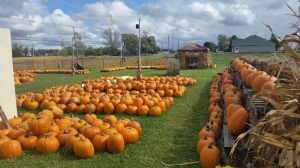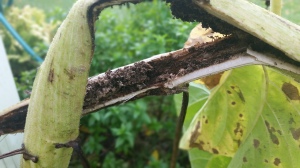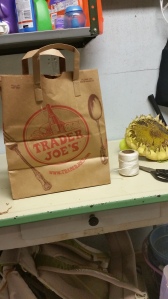Oh boy, it’s been a busy week! With Halloween and my parents coming to visit, and some Christmas shopping accomplished, I had a full weekend! The weather was less than desirable, we ended up getting some snow on Saturday! Last weekend was absolutely beautiful, and I was ready to accomplish the second phase of my fall preparation for my garden, but I guess that was not meant to be. I pulled muscles in my lower back yet again, and I was sidelined for the whole weekend. So, in between snowflakes that are forecasted for next weekend, I need to start cleaning up the gardens! I figured while I have some down time allowing my back to rest and heal, I thought this would be the perfect time to reflect on this past growing season and evaluate what I did well with what I did not do so well.
Overview:
This was actually a very hard growing season for Western New York. We came off an unusually cold Winter that included two blizzards that shut down the city of Buffalo. We were in the single digits for most of the Winter; no thaw came at all! And because of this brutal cold, the ground stayed cold right into June. Unfortunately, I lost a few plants due to the Winter, and I had a really hard time growing anything I had planted. In fact, most of my plants didn’t really start “growing” until August and bloomed right into September!
Pros:
– The new bed I had my husband roto-till in early spring was just the right size for my yard and my lifestyle. As the old saying goes, “don’t bite off more than you can chew”. I was a little nervous that I might have gone in over my head,that I wouldn’t be able to maintain it. It actually turned out to be just right.
– I added MANY new plants this year. It was pretty much an addiction. I kept buying plants right up until August when all the spring nursery stock was marked down 50%! Spring nursery stock is just a term used to describe plants, shrubs, trees and flowers available for the new growing season.
– This was the first year I was able to enjoy my garden. After six years of planting, transplanting and expanding, my back yard is finally looking like the beautiful, lush, oasis I wanted it to. I bought a few Adirondack chairs and would sit out in the backyard early in the morning listening to the birds and drinking a cup of coffee, all before my daughter woke up. It was the best feeling in the world.
Cons:
– I did not water enough. Water, Water, WATER. Even though, I must say that I was a lot better this year with watering all of my new plants, I could have done better. Plants you purchase and put into the ground need a ton of water to establish, or as I like to say, “make themselves at home”. Then, once they are established, you don’t have to water as much.
– I need to mulch a little more than I did. This would have helped out with my water situation! It’s amazing how much of a difference mulch does make for beds, such as the ones I have in the far back of my yard, when you can’t get the hose to reach out that far! I have also been interested in making a compost pile.
– I didn’t fertilize as much as I should. I usually fertilize with the Miracle-Gro liquifeed for maybe the first 4-6 weeks of the season. I probably only did it two times this year. I think this would have aided in earlier blooms in my garden.
All in all, progress was made this year, I am happy with that. I have big plans for next year, so that makes me all the more anxious to get out there and get “growing”!















